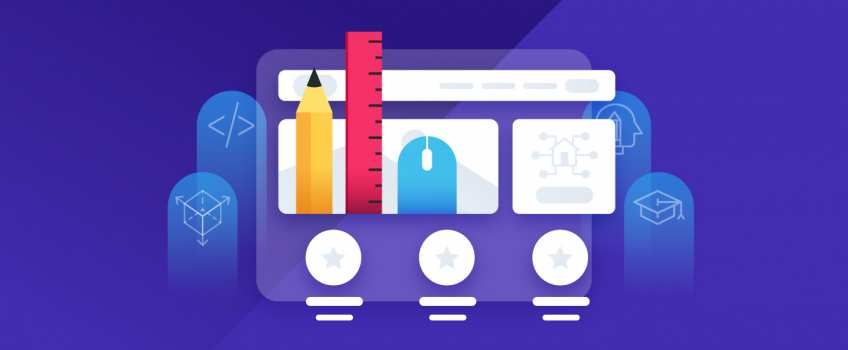Top 6 Data Science Use Cases in Design

Nowadays, industries are privileged by the opportunity to apply data science to reach new heights in their efficiency, productiveness, and overall success. The range of these opportunities is pervasive starting with advanced calculations for the business to customer service quality. Besides, the data collection is much simpler than ever before.
As for the companies working in the area of design, data science may bring numerous benefits. Design is the field of activity where creativity and technologies have to work together. Therefore, data science is being widely applied in design. In this case, design is an umbrella term, which includes various areas of activities employed by design-driven businesses. Moreover, the design is one of the most fast-moving and challenging areas of activity. Thus, data science application, in this case, is a must.
Let us dwell on the vivid examples of how data science applications change the design industry.
Industry knowledge
The importance of industry knowledge in the processes of product development and design is indisputable. Nowadays, customers tend to pay particular attention to product design. Much attention is being paid to the esthetics and emotional context hidden behind forms, colors, and textures. Industry knowledge in combination with customers’ needs and preferences can largely contribute to the success of a product on the market.
But how is it possible to design a product that will fully satisfy customers’ needs, meet their expectations, and fulfill all the necessary tasks properly?
This is the stage where various types of knowledge should be brought together to design a product matching all these requirements. The term 'design thinking' is often used to nominate the solution to this process of finding. Data science algorithms and methods help to collect and analyze data to get as many valuable insights as possible. Design thinking process will address these insights to personalize decision making, predict customers’ behavior, etc. All in all, the combination of various knowledge and approaches will result in the product that will be so close to an ideal product, that the customers will be willing to buy.

Product development
New product development is a combination of steps aimed at creating the product from scratch and introducing it to the market. Product design is one of these steps.
Data science algorithms help to discover hidden trends and sentiments before even introducing a product to the market. Millions of product reviews, comments and discussions provide a vast field for advanced analysis.
Smart homes
Recently, Big Data penetrated various spheres of human life. It has dramatically affected the way we live, manage our homes, and the way we build them. Thus, our homes have become smart homes due to modern technologies.
The application of modern technologies is aimed to facilitate routine tasks for people. However, the progress of these technologies does not seem to slow down. Thus, home design has to adapt and adjust to new requirements as well. Home automation and smart integrated solutions require a certain level of personalization and the ability to be adjusted according to customers’ desires. Self-learning and adaptive smart home frameworks are impossible without data science algorithms and techniques.

Human-centered design
Human-centered design is a new framework of design and management dedicated to the development of various solutions based on the human perspective. It is built on the principle of participatory action research. Thus, the solution to the problems is found via stages of observing, initial framing, monitoring, analysis, etc.
The application of human-centered design brings numerous benefits to a business. Human-centered design results in the fabrication of highly usable products. In its turn, the customer receives the product which is easy to use, and you get the reduction in costs for help desks and support systems. Moreover, the reduction in stress level and increase in productivity, efficiency, range of capabilities, and accessibility are also within the powers of human-centered design.
This framework is focused on designing a product perfect for a customer. Therefore, detection of meanings and sentiments, customer segmentation, and many other data science applications are crucial for human-centered design.
Gaming
Big data has become a powerful driving force for game design as well. Data-oriented/driven game design is the most widely-applied approach in game development. Traditional supervised learning algorithms perfectly fit the tasks of improving game design.
Data-driven game design is concentrated on the optimization of various systems levels of the game. Thus, you can choose a specific part of code like animation, navigation, cache utilization, etc. and apply data science techniques to improve it. As a result, the customer satisfaction rate will grow as well.
The task of any game designer is to apply his creativity and modern technologies to create a game that is exciting, intuitive, and easy to navigate. Data science, in this case, helps this designer to make data-based decisions and test his ideas before bringing them into life.
UX design
Web development and UX design are being considerably improved due to the broad application of data science. Undoubtedly, these are the areas that require a strong creative background and a specific passion for art.
With the penetration of data science into web design, the process became more data-based, logical, and well-organized. Let’s take a closer look at several bright instances of how data science can improve your web design services.
Managing expectations
Data analysis helps the designers to create websites that are highly-responsive, easy to navigate, and logically structured. The beautiful and functional website attracts more visitors, makes them stay longer, and become faithful followers and customers. Application of various machine learning techniques and algorithms facilitates the collection of customers’ insights and tracking of corresponding website metrics.
Even a website layout may be improved using the dynamic website design, which allows skipping the A/B testing stage and saves resources and time. Besides, heat map analysis helps to identify the elements catching the customers’ attention and even measure the intensity of this attention.

Customers segmentation
Customer segmentation and personalization allow us to make website design adaptive and responsive. By gathering the insights, you can provide your customers with unique, appealing images and color schemas. In this way, you make a customer feel unique and valuable for the company.
The same image may be used for different purposes and have a disparate impact on customer segments. Therefore, the analysis of such reactions is beneficial for the website design process.
Handling edge cases
Application of smart technologies provides the capacity to remember customers’ preferences and conduct sentiment analysis. Specific virtual assistants may become an efficient tool in gathering these insights.
Thus, these chatbots become a real personal assistant for a customer collecting the insights as a trustworthy and reliable friend. The edge cases present the situations related to misunderstanding or extreme dissatisfaction of a customer. The artificial intelligence-powered bots detect such instances and provide them for further analysis to avoid such issues in the future. Therefore, web developers get the capability to build data-driven strategies and even more engaging websites.
Conclusion
Companies all over the world strive to apply data science for their benefit. Modern design without data science techniques and algorithms is a mere waste of time. Nowadays, the main success rule is to collect, analyze, and make data-driven decisions for further constant improvement.
The more accurately your product is designed, the more customers will find it a perfect fit for them. Enhanced personalization, impact prediction personalized assistance and support are several among numerous use cases that make the customers' satisfaction rates skyrocket. Data collection, application of various analytical techniques, development of design strategies, and recommendations will definitely bring you to success.



Comments
Add a new comment: